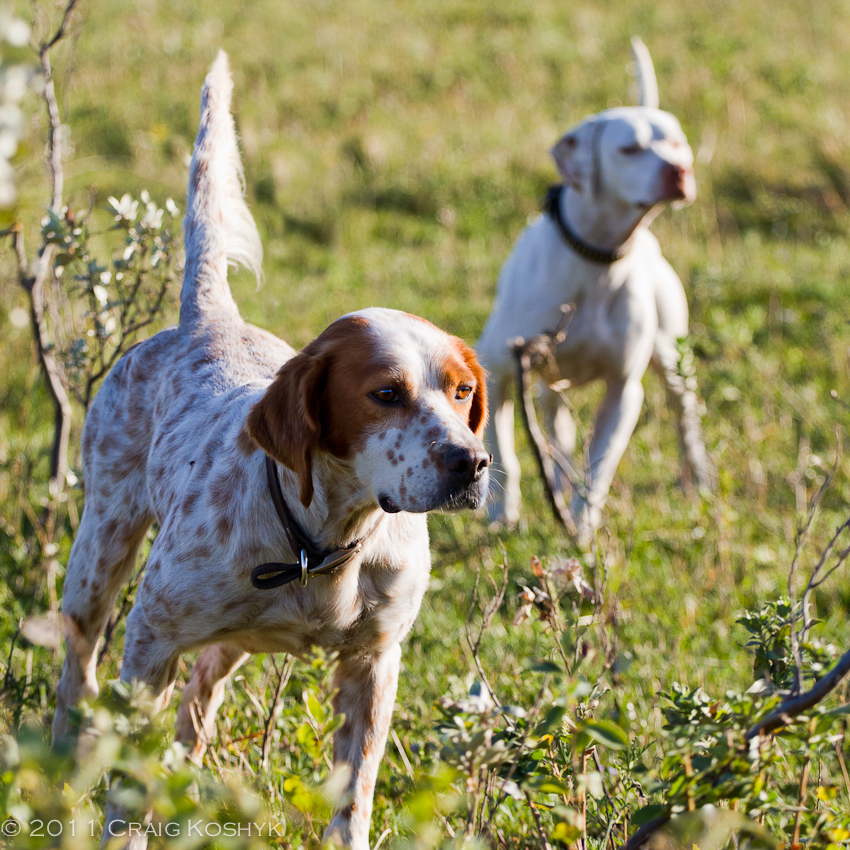Here and There, Part Two
In Part One of this series, I provided a brief overview of the differences and similarities in the overall bird dog and hunting cultures of North America and Europe. In this post, I'd like to take a look at the overall populations of the British and Irish pointing breeds in parts of Europe and the US.
In the US, it is difficult to determine with any accuracy, just how many Pointers or Setters are produced every year. But, based on a few sources of data currently available from around 2008, it looks like within the AKC, the Irish Setter is the most popular of the setter breeds with about 1000 registrations per year. It is followed by the Gordon Setter with about 5-600 per year and the English Setter which currently sees fewer than 100 registrations per year. The Irish Red and White Setter was only added to the AKC's list of recognized breeds in 2009. I've been unable to determine the number of registrations in that breed per year, but the AKC lists its popularity near the bottom, at 149th place on a list of 178 breeds.
It has long been assumed that over the last 100 years or so, roughly equal numbers of Pointers and Setters (mainly English) are registered with the FDSB each year. In 2004, for example, Field Trial Magazine published stats indicating that the numbers were 6,256 Pointers and 4,906 Setters registered in 2003. But again, like the AKC, the FDSB has been experiencing a decline in the number of dogs registered each year. Currently, based on the total number of all breeds registered per year by the FDSB, it looks the combined number of Pointers and Setters registered with the FDSB each year is below 5000. Nevertheless, among North American hunters Pointers and Setters remain quite popular and in some field trial venues, like all-age horseback trials and cover dog trials they represent the gold standard of performance and completely dominate the scene from Manitoba to Mexico.
Here is a video of an English setter from American lines hunting in classic ruffed grouse terrain in the US.
In much of Europe however, Setters outnumber Pointers by a huge margin. A recently published chart shows that the English setter makes the top ten list of all breeds in several European countries. And in Italy, the English setter is the most popular of all dog breeds with annual registrations of up to 20 thousand pups!
It is hard to say why the English Setter is so popular in many parts of Europe. I wrote about breed popularity here and rarity here. But recently, I posted a question on one of the top online forums for the discussion of hunting dogs in Italy asking Italian hunters, why they loved the English setter so much.
Some of the answers supported my belief that influential voices can have a huge effect on popularity. "The English setter is the most popular dog for hunters and field trials because many of the big name writers who wrote about hunting dogs in the 60s were Setter men. 's books about hunting woodcock with setters were very influential. And all you had to do was open any hunting magazine like Diana and you'd find many articles on English Setters."
And others supported my assertion that once a breed achieves a certain level of popularity, it can grow so strong that it completely dominates a local scene. "Among the hunters in my valley, approximately 95% of them hunt over setters. I hunt over them because all my hunting friends have them and my father who hunts with me also has setters. Around here, the word 'Setter' is more or less synonymous with 'hunting dog' "
Another respondent, only half-jokingly wrote that the English setter appeals to fundamental qualities of Italian culture. "Italians have very refined tastes in many areas, in the kitchen, at the table, in fashion, design and architecture and Italy is the motherland of some of the greatest writers, artists and composers in history. So a breed like the English setter, with such incredible beauty and talent, fits perfectly with our passion for the finer things in life."
Here is a video of English setters from Italian lines hunting woodcock in the alps of northern Italy.
Of course, when it comes to the British and Irish breeds of pointing dogs, the biggest outlier in Europe is Germany. There, the most popular pointing dog is the Deutsch Drahthaar, followed by the other German pointing breeds. Other pointing breeds, even breeds that are super popular elsewhere are barely on the radar. Nevertheless, there are a few Setters and Pointers in Germany and there are German clubs for their breeds. The German Pointer club has actually been around for over 100 years. I will write more about the Pointer and Setter scene in Germany, especially about its fascinating history, in an upcoming post. But for now, here is a video of Setters and Pointers running in a field trial in Germany.
Enjoy my blog posts? Check out my book Pointing Dogs, Volume One: The Continentals
















AKC registers 500-600 English Setters per year right now (about 100 litters though). This is down from a few years ago when they were consistently registering about 800-900 dogs per year.
ReplyDelete